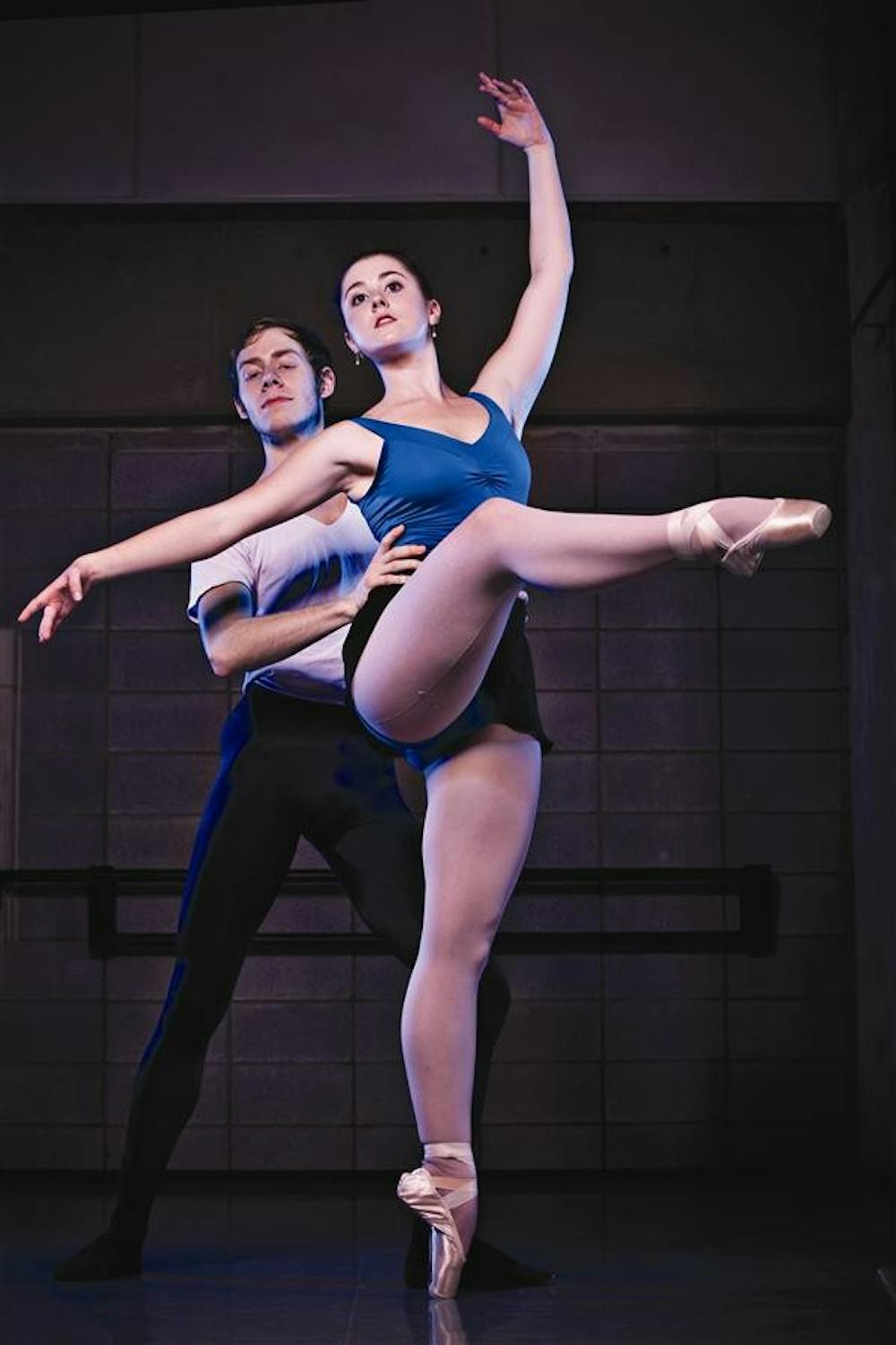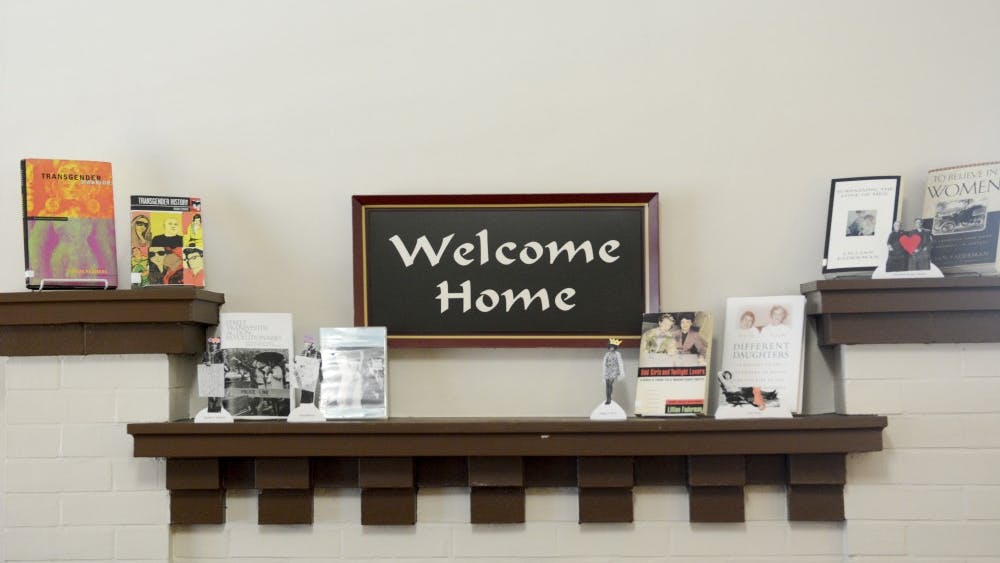Lines of perspiration bleed through Annie Duffey’s pink leotard. Thirty minutes into class, and already the dancers are sweating. Guys wipe their foreheads and necks while girls peel off layers of clothing.
“One, two, three, four, out, out, plié,” barks an instructor. “Out, fifth, out, fifth. And the other side.”
Leather shoes rub against the floor as the dancers turn, adding a symphony of squeaks to the classical music.
The instructor strides around the room like a drill sergeant, demanding grace. The combinations are tough, but that doesn’t stop Annie from seeking perfection. Don’t get discouraged, she reminds herself. Like many of the dancers, Annie has been awake and moving for hours. She squeezes in education classes at 8 a.m. and reads Voltaire over the weekend for her French class. Her ballet schedule — dancing from 11:30 a.m. to 5:45 p.m. all week and teaching “baby ballet” classes on Saturday mornings — runs her life.
She’s at IU to control what little she can of her future. Her dance career will be fleeting at best. Annie knows she’ll be lucky if she can dance until she’s 35. Her outside field — elementary education — is a safety net to protect her when it’s all over. Even a few years of dancing will make the training worth it.
“Rise,” the instructor bellows to the dancers on the floor.
Now it’s Annie’s turn. She banishes her distractions — French homework, upcoming auditions, throbbing feet. She can’t even focus on remembering the combination of steps. It’s all about precision and discipline, controlling every muscle. Each step needs to be as good — no, better — than the last.
She’s moving gracefully across the room, light on her feet and concentrating on the grande allegro combination. She leaps. The piano is too close. Her right leg folds under her. Crumpled on the floor, she doesn’t get up.
The pain is disorienting, like a blackout. Someone has propped her right foot on a chair and tucked a blue piece of fabric under her head. The ballet department’s trainer Laura Mertz crouches near her right foot, gingerly touching the ankle. One of Annie’s roommates, Ben Warner, has moved from the bench to sit by her side.
It’s all happening so fast. Ben and Laura hoist Annie up off the floor, each supporting an arm as she limps down the hall. The trainer’s office is on the fourth floor of the Musical Arts Center, a level beyond the reach of the elevator.
She hops up ten steps, and then ten more.
On a padded table, Laura looks at her ankle. She peels off her right shoe.
“Can you pull your toes back?” Laura asks.
“I can’t go back all the way,” Annie says, flexing her foot.
“Just relax,” Laura soothes. “Does that bother you?”
Annie looks to the left and grimaces. “Yeah, that really hurts.”
The pain gnaws at her ankle and eats away at her confidence. Is everything over?
“The Nutcracker” rehearsals just started. Will she be able to perform? Will she be able to audition for a job, graduate, and get out of here?
One short leap, one misplaced step, one lapse in concentration, and a dream 16 years in the making could end in a second.
Of course, Annie thinks, of course this would happen. During last year’s dress rehearsal of “Swan Lake,” she twisted the same ankle. The fall wasn’t nearly as bad as her current injury and she got up and kept dancing. After almost 10 minutes of movement, she went to the dressing room to change into her swan outfit. In that lull, the adrenaline slowed and the pain kicked in. No longer able to stand en pointe, Annie sat out the first show and only performed in one act the second night.
She took a week off after the performance, but even then she came back too fast.
Most injuries don’t happen in class. They sneak up on dancers right before or even during a performance. Long, intense rehearsals can exacerbate aches and pains. The trick — and the challenge — is to keep the injury at bay.
During the fall ballet, Ben developed shin splints from repeated jumps in one of the numbers. The trainer massaged his shins to keep the pain from getting worse. Another dancer has been nursing a stress fracture.
Dancers must know when to push and when to take a step back. “You’re in control of yourself and that’s all,” Ben says. The drive for physical perfection can push some dancers to seek the impossible.
Take weight, for instance. Dancers should be small enough for men to hoist gracefully into the air, but strong enough to endure unrelenting physical demands. Despite the ballerina stereotypes, the department chair says eating disorders are not common at IU. Dancers constantly sip coffee and hot chocolate in the studio. There’s even an occasional donut. At home, Annie’s roommates chop shallots and roast vegetables for butternut squash risotto.
“You can’t really change your body,” Annie says. “That’s where eating problems come in. You’re never really going to be satisfied.”
Instructors and students understand that these physical limits can’t be taught. It’s a kind of self-awareness that comes with experience, patience, and, very often, pain.
•••
Posters of dancers are haphazardly Scotch-taped to the wall of Laura’s office. They’re the kind of photos you would expect to see in a training room: inspirational images of dancers perfectly posed in a forest, on a snowy field, and even in a meadow of daisies.
At home, Annie has her own wall of inspiration. Small pictures of her favorite dancers grace a bulletin board. They’re nestled next to Catholic rosary beads and a flyer from the Boston Ballet. Growing up in a Boston suburb, Annie spent her afternoons, evenings, and weekends dancing at the Boston Ballet School. Even in high school, ballet dominated her life. As she watches her younger twin sisters dance their way through high school, she’s reminded of all the things she sacrificed: student government meetings, horseback riding, lifeguard training, and elaborate class projects. The demure dancer photos stuck to her board are a reminder of everything she’s working toward.
But on the trainer’s table, Annie is fighting back tears.
“Do you want me to go get your crocheting?” a fellow dancer asks. “Now’s the perfect time to start a blanket.”
Another dancer comes over and kisses her on the forehead. Friends filter in and out of the room, checking to see how she’s doing. So many of them have sat on those padded maroon tables before.
Laura grabs an ice pack from the freezer and places it on Annie’s ankle. “You might have sprained it again,” she says. “It’s hard to tell with all that swelling. Pretty much anything I do is going to hurt.”
“Do you think it’s anything other than a sprain?” Annie asks.
“No, I don’t think you fractured anything,” Laura says, eliciting a sigh of relief. “This is something you can really come back from.”
Annie gives two thumbs up. It’s not all over. But how long until she can dance again? A week? Two weeks? Her muscles weaken every day she sits on the bench. Job auditions are creeping closer, and she needs to be ready.
•••
One week after the accident, Annie’s ankle has turned into a purple-blue bruise. For a few days, Ben drove her to class on an electric scooter, but now she’s walking. All week she’s been watching classes and rehearsals. Today is the first day she’s been able to do physical therapy — some Pilates and biking — and she has the go-ahead from Laura to participate in bar classes Monday.
For the moment, however, she’s stuck sitting on the bench watching “Nutcracker” rehearsals. Pairs of dancers glide across the floor as the department chair looks on.
“Stop, stop, stop,” he says, waving his arms at the pianist to cut the music.
Everyone huddles around an old television to watch a DVD of the dancers performing the same number last year. Then it’s back to the floor. Cue the music. The dancers float across the room.
Sitting on the bench, right leg propped up on a chair in front of her, Annie is dancing. She knows she can’t put on her pointe shoes yet. She can’t leap and spin and be lifted into the air. But she’s determined to keep up. Sweeping her arms gracefully from side to side, replicating the moves of couples of the floor, she dances.
Demanding grace
In the Ballet Department, preparing for your career can make you stronger or break you down. A dancer takes us inside her uncontrollable world.

Get stories like this in your inbox
Subscribe





